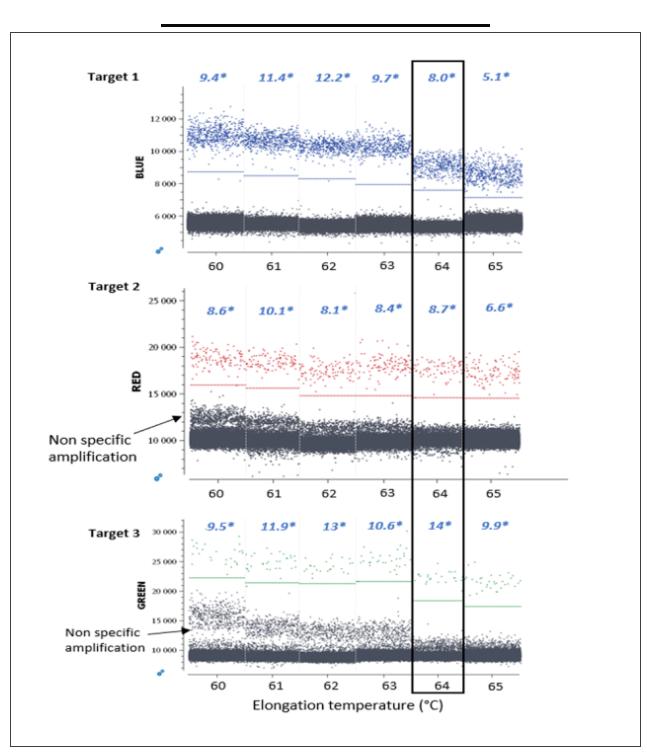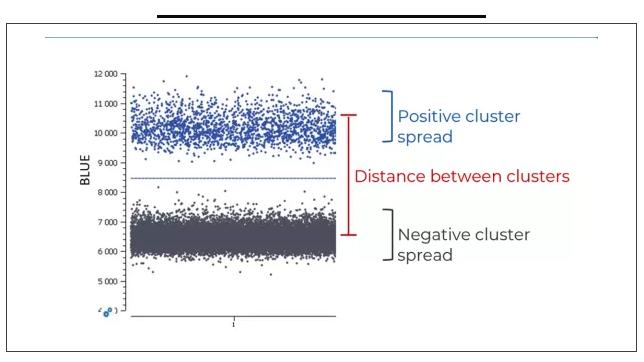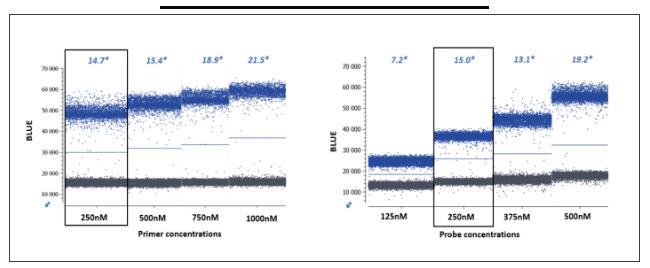

Stilla Technologies Digital PCR System
naica®Crystal Digital PCR System
NaicaTMCrystal Digital PCR System
Azure Biosystems Real-Time PCR Systems

By measuring several targets in a single reaction, multiplex assays enable users to conserve precious sample volume and to save time, reagents and costs. In addition, as all targets are amplified and measured in the same reaction, multiplexing improves quant巾cation precision by reducing pipetting errors that contribute to sample and reagent variations when performing separate single-plex reactions. Multiplexing in Crystal Digital PCR™ is as sensitive and accurate as single-plexing. Careful assay design and assay optimization steps help realize the more complex reaction composition, containing a high number of primers and probes for the amplification of several DNA targets in a single PCR reaction. The Crystal Miner software is an open data analysis software that provides intuitive tools to help optir丫1ize and troubleshoot multiplex assays. This Technical Note provides straightforward guidelines to fac山tate multiplex assay design using the naica®system.
Guidelines for experim entally evaluating primer and probe performance
1.Stilla® recommends using the naica® multiplex PCR MIX, which is specially formulated for optimal multiplexed Crystal Digital PCR™ performance.
2.It is imperative to start with a Crystal Digital PCR™ run of the individual reaction composition in the single plex format first. Each primer/probe/target requires a performance verification in the less complex reaction mix before proceeding to multiplexing. For example, for a 3-plex assay, three individual single-plex reactions should first be performed on control nucleic acid target templates before combining the reagents in a multiplex reaction. W hen performing a single-plex reaction, a single positive population is expected.
3.For optimized multiplex assay performance, it is important to consider the final sample matrix and composition (e.g., short fragmented DNA for assay design targeting circulating cell-free DNA, more intact DNA fragments for assay design targeting genomic DNA.
4.The DNA template used should be devoid of contaminants and potential inhibitors. Synthetic oligos can be used as templates for assay optimization if final sample material is rare or not readily available.
5. A range of elongation temperatures should be evaluated for each single-plex reaction to determine the optimal reaction temperature at which there is good separability between positive and negative populations, without non-specific amplification (Figure 1). The Stilla® separability score provided by Crystal Miner software (Figure 2) should be used as a metric to determine the optimal elongation temperature common to all probes. If the single-plex reaction is not well optimized, a second distinct amplified population may be apparent due to, for example, undesired probe interactions. In addition, non-spec们c ampli们cation can result from one of several unoptimized parameters, including primer/probe dimers or primer/probe non-specificity. In this case, various methods can be employed to limit the ampli们cation of non-spec们c sequences, such as increasing the annealing temperature, performing a touchdown PCR or redesigning primer sequences. It is important to evaluate the primer and probe interactions using adapted in silico tools before testing the reagents in vitro.

▲figure l. Crystal Miner software 7D-dotplots of single-plex reactions showing the fluorescence intensities obtained in the blue, green and red detection channels across a range of elongation temperatures from 60°C to 65°C. The black box indicates the shared optimal elongation temperature selected for the single-plex reactions. Separab山ty scores (*) can be used to determine the optimal elongation temperature for amplification of the 3 targets.

▲figure 2. Separab山ty score is based on the distance between clusters, and positive and negative cluster spreads The Separab山ty score is automatically computed by the Crystal Miner software and can be found under the Advanced QC tab.
6.Perform multiplex Crystal Digital PCR™ with all primers and probes at the selected elongation temperature and evaluate the reaction performance using the separab山ty score as a guide If necessary:
★ Adjust the number of PCR cycles- It is recommended to start with 45 cycles and to increase the cycle numbers for further optimization of the separab山ty between the positive and negative populations.
★ Adjust primer and probe concentrations- For the naica® system, the recommended primer and probe concentration range from 0.725 to lµM (figure 3). For multiplex assay design 代IS recommended to start at the low end of the concentration range to minimize the complexity of the reaction and reduce the volume occupied by primers and probes.

▲figure 3. Crystal Miner software 7D-dotplots showing the fluorescence intensities obtained in the blue detection channel across a range of increasing primer (left panel) and probe (right panel) concentrations. The black boxes indicate the selected concentrations to be carried over for use in the multiplex assay based on favorable separab山ty scores and low primer and probe concentrations.(*: separab山ty score)
★ Use modified bases such as locked nucleic acid {LNA)7 bases or a minor groove binder {MGB)2 to increase the Melting temerature {Tm) of the probe while keeping a short length {<20nt if possible) However, no more than 2 MGBs are recommended in a multiplex assay due to a risk of decreased amplification.
7.Evaluate primer and probe interactions- The probability of homo/hetero dimer formation between primers and/or probes used in the same multiplex experiment should be kept to a minimum. Dimerization can be evaluated, and interaction scores determined with several in silico design tools (e.g., IDT OligoAnalyzer™ Tool, Primer 3, Primer express, Beacon designer) {Figure 4). High concentrations of primers and probes can increase the probability of undesired interactions. Thus, when multiplexing, it is recommended to start with low concentrations of primers for all assays (e.g., 0.25µM), and increase the concentrations gradually up to lµM if needed (for example, to increase the amplification efficiency).

▲figure 4: Examples of interactions between primers and probes. a) Interaction between the probe of target land the reverse primer of target 2 (R2 target 2, red box). This interaction is not detected when using the reverse primer Rl target 2. In this example, Rl target 2 should be selected for the design of the multiplex assay. b) Interaction between the probe of target land the forward primer of target 2 (F2 target 2, blue box). This interaction is not detected when using forward primer Fl target 2. In this example, Fl target 2 should be selected for the design of the multiplex assay
8.For a multiplex assay, it is important to compensate for fluorescence spillover to ensure robust quant巾cation. Using monocolor controls, the Crystal Miner software allows to create a compensation matrix adapted to a given multiplex panel. For further detailed description of fluorescence spillover, please visit h ttps://www.gene-pi .co m/ite m/s pi 11-ove r-2/ Instructions for performing fluorescence spillover compensation can also be found in the Crystal Miner software User Manual.
